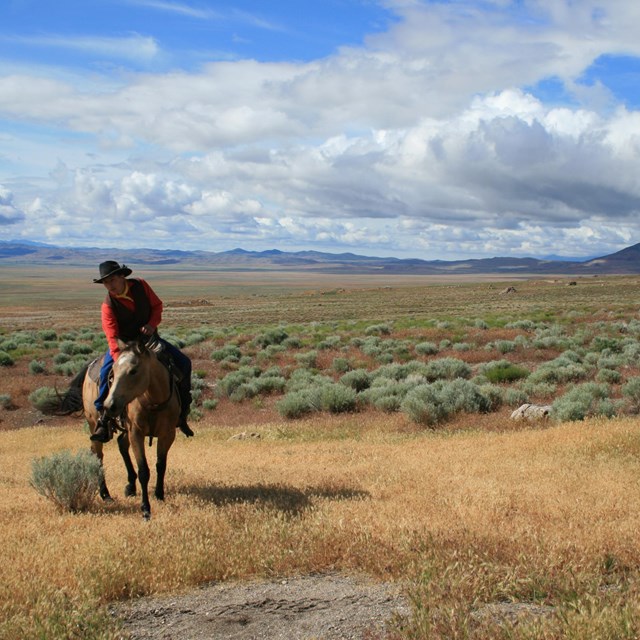Last updated: June 13, 2022
Article
Pony Express Trail Timeline
Here Comes the Pony!
The Pony Express has fascinated Americans since its first riders hit leather in April 1860, heading west from St. Joseph, Missouri, and east from San Francisco, California. This innovative overland mail service lasted only 19 months, but it created an immediate sensation and won a permanent place in the history of the American West. The legend of “the Pony,” as it was affectionately known, may overshadow its brief history, but the bold founders and brave riders of the Pony Express helped spread important news, shrink a continent, and bind a nation that was being torn apart by civil war.
Spreading the News
For millions, email and the Internet have replaced letters and newspapers. But, how did we communicate 50, 100, or 600 years ago? At right are highlights of some key people, inventions, and technologies that changed how we spread the news.
1454
Johannes Gutenberg invents a printing press with metal, movable type. The press enables the mass production of documents that spread news and exciting ideas of the Renaissance.
1769-1807
James Watt perfects the steam engine. Benjamin Franklin becomes first Postmaster General under Continental Congress. Robert Fulton’s steamboat Clermont begins passenger and mail service on the Hudson River.
1830-1832
U.S. rail service begins from Baltimore to Ellicott’s Mills, Md., 16 miles west. Steam locomotive sets record speed of 30 miles per hour. Mail delivery by rail begins in Pennsylvania.
1837-1844
Samuel Morse develops telegraphy, a method of sending electronic messages over wires. Morse patents dot-and-dash alphabetic code. First U.S. news sent by telegraph: Henry Clay is Whig party nominee for President.
1860-1861
Pony Express begins mail service April 1860 between St. Joseph, Mo. and San Francisco, Ca. Transcontinental telegraph lines completed, October 1861. The Pony delivers last mail November 1861.
1868
First successful telegraph cable operates between England and Canada, with land lines to U.S. Transatlantic news is delivered at speed of two words per minute, beating the next fastest method—10 days by steamship.
1869
Union Pacific and Central Pacific connect rails at Utah’s Promontory Summit. Transcontinental train service begins for passengers and mail.
1876-1877
Alexander Bell invents telephone. Thomas Edison records and plays back sounds cut into grooves on a wax cylinder. First recorded words: “Mary had a little lamb.” Eadweard Muybridge demonstrates high-speed photography.
1896-1901
Guglielmo Marconi tests and patents wireless telegraphy (radio); transmits signals from England to Newfoundland. Proves messages can be sent on electromagnetic waves, roughly at speed of light. Valdemar Poulsen develops magnetic recordings, basis for today’s data storage on disk.
1903
Pres. Theodore Roosevelt sends first public wireless message (to England’s King Edward VII), sparking a revolution in global communication. Orville and Wilbur Wright take turns flying first motor-driven airplane at Kitty Hawk, N.C. Last flight of the day: 852 feet in 59 seconds.
1906-1915
Lee DeForest invents triode vacuum tube amplifier; makes possible long-distance telephone calls; paves way for sending voice by radio. Woodrow Wilson, calling San Francisco from White House, says, ”It appeals to the imagination to speak across the continent.”
1926-1927
Sparton Corporation introduces electric radio. AT&T demonstrates television— team in New York hears and sees Secretary of Commerce Herbert Hoover from Washington, D.C. Hoover says, “I am glad to welcome television as the latest product of scientific discovery.”
1946-1948
Researchers build ENIAC, the first all electronic digital computer with input, output, and memory; it has 18,000 vacuum tubes and fills several rooms. First live telecast of baseball’s World Series: New York Yankees beat Brooklyn Dodgers. Scientists invent transistor, setting stage for microelectronics.
1960s
“Live via satellite.” Telstar 1, first active telecommunications satellite, ushers in era of real-time global TV transmissions. Department of Defense develops Advanced Research Projects Agency Network (ARPANet), an information networking system, precursor of the Internet.
1970-1980s
Altair Microcomputer Kit—first personal computer—is marketed to home enthusiasts. Radio Shack introduces first fully assembled personal computer with keyboard and monitor. BITNET (Because It’s Time NETwork) provides file transfers and email.
1990s
Computer scientist Tim Berners-Lee develops World Wide Web. Entire encyclopedia stored on CD-ROM. Wireless applications allow access to the Internet via cell phones. Instant messaging skyrockets. Millions worldwide use email and the Internet.
2002-2003
In U.S. more email messages sent than postal mail. FCC reports 122.4 million wireless phone subscribers in U.S. Networks send more than six trillion bits of data per second over fiber-optic lines, about one million images per second.


